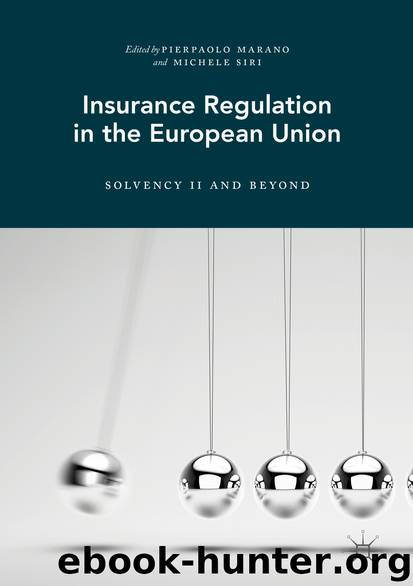Insurance Regulation in the European Union by Pierpaolo Marano & Michele Siri

Author:Pierpaolo Marano & Michele Siri
Language: eng
Format: epub
Publisher: Springer International Publishing, Cham
Questionnaire Method (and Results)
The online survey entitled “Insurance firms’ Maturity in Risk Management” was purposely designed for the present study after consulting the various ICPs highlighted earlier and the relevant literature on the subject. Given that two of the authors are members of the Federation of European Risk Management Association (FERMA) and that they are also actively involved in various insurance-related forums (e.g. LinkedIn), an e-mail containing a link to the online survey above was sent to potential respondents, these representing a critical case purposive sample (Saunders 2012).
The respondents were requested to provide in Section A of the questionnaire information concerning (a) their position/role with their institution, (b) their experience (in years) in the field of risk management, (c) their institution’s main sector of activity and (d) the number of full-time employees registered with their institution.
In Section B, the respondents were presented with 18 four-point Likert-type items (ranging from 1 = strongly disagree to 4 = strongly agree) to reflect the state of the risk management maturity of organisations. These items comprise (a) four items on owned and documented procedures and policies (e.g. “Our institution has a risk committee and defined terms of reference”), (b) three items on risk-conscious management (e.g. “We have a risk culture oriented towards profit increase rather than risk-profit balance”), (c) four items on good communication—communication of appetite/tolerance and between internal control functions (e.g. “We have a single approach to risk culture with set limits”), (d) four items on the due importance given to risk management practices (e.g. “Risk management practices are critical in providing added value to our institution”), and (e) three items concerning proactive risk management (“Any recommendations made are appropriately addressed and remedial action is taken in good time”). Higher scores were indicative of higher maturity in risk management.
These 19 statements were randomly ordered while some were reversed to keep respondents from answering carelessly and to help correct for agreement bias. Respondents were informed that there were no ‘right’ or ‘wrong’ answers, that their responses would be kept confidential and that the overall findings would be used only for research purposes.
The URL was restricted to allow only one respondent per IP address and respondents had the option to edit the survey until they submitted it. A total of 710 respondents completed the survey during January 2014. These measures represented the organisations’ risk management maturity before the introduction of Solvency II.
The same respondents were invited to participate again in our survey during June 2015 using the e-mail addresses that they had previously provided, and this time we received 507 complete responses; these measures representing the organisations’ risk management maturity after the introduction of the Solvency II and the relevant implementing measures. Hence the data set used in this study consists of pre-post measures of 505 respondents, with the remaining 202 completed surveys gathered in the first survey having been discarded.
The 505 respondents participating in the survey occupied the following roles/positions within their institution: control functions (64.5%) and managerial functions (35.5%). They had on average circa three years of experience in the field of risk management (M = 3.
Download
This site does not store any files on its server. We only index and link to content provided by other sites. Please contact the content providers to delete copyright contents if any and email us, we'll remove relevant links or contents immediately.
The Secrets of Successful Financial Planning by Dan Gallagher(1461)
A Knight's Reward by Catherine Kean(1293)
An American Sickness by Elisabeth Rosenthal(1212)
Against the Gods by Peter L. Bernstein(1068)
America's Bitter Pill: Money, Politics, Backroom Deals, and the Fight to Fix Our Broken Healthcare System by Steven Brill(1035)
FREAKONOMICS by levitt steven d(1028)
SuperFreakonomics by Steven D. Levitt(1026)
America's Bitter Pill by Steven Brill(1007)
Risk Management Framework by James Broad(996)
Strategic Risk Taking: A Framework for Risk Management by Aswath Damodaran(979)
A Practical Introduction to Security and Risk Management by Bruce Oliver Newsome(975)
2019 Social Security & Medicare Facts by Michael D. Thomas(974)
Game Changers by Rudolf Taschner(941)
How Our Days Became Numbered: Risk and the Rise of the Statistical Individual by Dan Bouk(923)
The New Frontier Investors by Jagdeep Singh Bachher Adam D. Dixon & Ashby H. B. Monk(912)
The 8 Characteristics of the Awesome Adjuster by Carl van Lamsweerde(897)
SUPERFREAKONOMICS by levitt steven d(893)
The Globetrotter's Guide to Travel Insurance: Travel Smarter, Pay Less, Get the Right Coverge (The Savvy Traveler Series Book 1) by Bauche Michael & Bauche Yvonne(881)
The Advisor Playbook: Regain Liberation and Order in your Personal and Professional Life by Duncan MacPherson & Chris Jeppesen(860)
